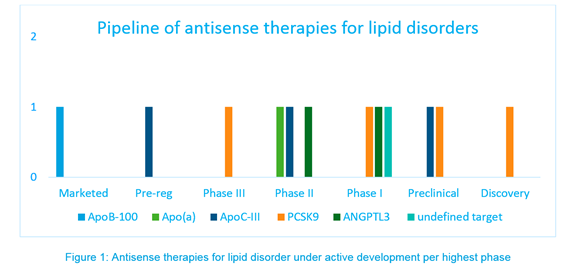





















- Blogs
- Antisense therapies in dyslipidemias
Background
Primary dyslipidemia is a genetic metabolic condition characterized by abnormalities of the lipid profile constituted by cholesterol, triglycerides (TG), and lipoprotein of five major classes: chylomicrons, very-low-density lipoproteins (VLDL), intermediate-density lipoproteins (IDL), low-density lipoproteins (LDL) and high-density lipoproteins (HDL). Dysregulation of lipoprotein and lipid metabolism is the greatest contributor of the development of atherosclerosis and coronary artery disease.
Some patients using standard statin therapy alone or in combination with other lipid lowering therapies are not able to achieve their LDL cholesterol (LDL-C) reduction goal, particularly patients with homozygous familial hypercholesterolemia. Hence, there is a need for alternative and adjunct therapeutic strategies for these patients and gene silencing approaches by antisense oligonucleotides (ASOs) and small interfering RNAs (siRNAs) have proven to be effective treatment options.
Familial hypercholesterolemia is caused by mutations in the following three genes relevant to plasma LDL metabolism: low-density lipoprotein cholesterol receptor (LDLR), apolipoprotein B100 (ApoB-100) and proprotein convertase subtilisin/kexin type 9 (PCSK9). Because gene silencing achieves inhibition of the production of selected proteins, specific therapies have been developed exploiting the target biology and knowledge of the lipid metabolism underlying the disorder. The targets investigated thus far, and the antisense therapies developed against these targets according to Pipeline Intelligence will be reviewed.
Targets of antisense therapies in lipid disorders
ApoB-100
ApoB-100 is an essential protein for the production of pro-atherogenic lipoproteins, namely VLDL, LDL and lipoprotein A. High levels of ApoB-100, especially associated with the higher LDL levels, is a primary driver for cardiovascular disease.
Apo(a)
Apolipoprotein (a) [Apo(a)] which is bound to ApoB-100 via a disulfide bond, leads to the formation of lipoprotein (a) [Lp(a)], a cholesterol-rich LDL-like particle. Lp(a) is a key driver for cardiovascular disease due to its association with an increased risk of coronary heart disease. Therefore, drugs that can lower Lp(a) levels by targeting Apo(a) are being developed.
ApoCIII
Apolipoprotein CIII (ApoCIII) is a 79-amino acid glycoprotein synthesized in the liver that has a role in the regulation of TG levels. ApoCIII is present on TG rich lipoproteins, such as VLDL. ApoCIII impairs clearance of these particles by inhibition of the enzyme lipoprotein lipase (LPL). It is also known to delay clearance of TG-rich lipoproteins. ApoCIII may also play a role in the activity of hepatic lipase and assembly and secretion of TG-rich lipoproteins. Therefore, ApoCIII plays a key role directly and indirectly in the pathogenesis of atherosclerosis and is being explored as a therapeutic target for hypertriglyceridemia.
PCSK9
PCSK9 promotes the degradation of LDL receptors and consequently increases levels of LDL-C in serum and eventually premature cardiovascular disease. Conversely, loss-of-function mutations are accompanied by decreased levels of LDL-C and a decreased risk of cardiovascular disease.
ANGPTL3
Angiopoietin-like 3 protein (ANGPTL3) is a liver synthesized inhibitor of lipoprotein lipase and endothelial lipase. ANGPTL3 inhibition has been shown to lower serum LDL, serum and liver TG levels.
The landscape of antisense therapies for lipid disorders according to Pipeline Intelligence is presented in Figure 1.

Conclusion
Despite the use of first-line statin therapy, many patients with familial hypercholesterolemia fail to achieve optimal reductions of LDL-C levels or are unable to tolerate statins. ASOs and siRNAs have proven to be effective as adjunct or alternate therapies in these patients.
Register to the INNsight Newsletter for regular patent, pipeline and conference updates.





